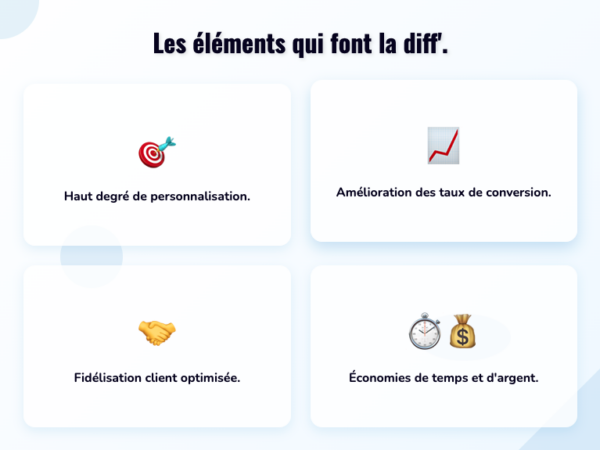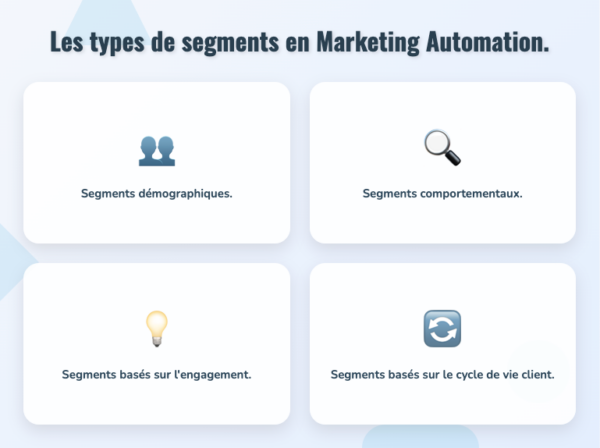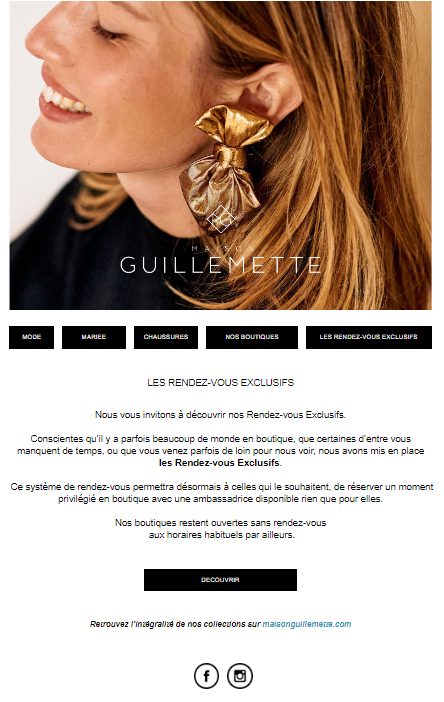Are you fed up of sending mass emails that don’t get you much? Or even end up straight in the bin?
We have the solution for you: get started in marketing automation (with ShopiMind)! But not just any old way. If you want to test marketing automation, then you need to use segmentation.
What is segmentation?
Segmentation in marketing automation isthe art of dividing your database of customers or prospects into distinct and homogeneous groups. The idea is to send the right message to the right person at the right time. And all this in an automated way. Not bad, eh?
The elements that make the difference:
- High degree of personalisation: No more “Dear customer”! With segmentation, it’s tailor-made. This allows you to stand out from the competition and capture the attention of your audience.
- Improved conversion rates: Relevant messages = more clicks, more purchases. It’s as simple as that.
- Optimised customer loyalty: your customers feel understood, they come back! You strengthen customer relations in the long term.
- Save time and money: ShopiMind will do the work while you concentrate on your real job.
 Segmentation in marketing automation is not just a trend. It is a real lever for growth for your company. It allows you to refine your understanding of your audience and adapt your marketing approach accordingly.
Segmentation in marketing automation is not just a trend. It is a real lever for growth for your company. It allows you to refine your understanding of your audience and adapt your marketing approach accordingly.
Key segments in marketing automation
OK, we understand that segmentation is the key to marketing automation.
But in concrete terms, how do you segment? And what parameters can be segmented? We are going to look at the main types of segments that you can create with a tool like ShopiMind.
1) Demographic segments
1) Demographic segments
This is the basis of the basis. We can mention:
- Age
- Gender
- Geographical location (country, region, department, city… and even according to a precise kilometre radius!)
- As well as any other data you have collected in your registration forms, on your e-commerce CMS
With ShopiMind, you can easily create segments based on these criteria. Handy for tailoring your offers according to age groups or geographical areas!
2) Behavioural segments
On an e-commerce site, there are e-commerce events that occur (logical). By exploiting them, this allows you to have a 100% personalised approach:
- Purchase history
- Products viewed
- Average basket
- Frequency of visits
- Progress through the order tunnel
- Time spent on the site
 Thanks to its module, ShopiMind allows you to track this behaviour and create ultra-precise segments. Ideal for targeting big spenders or following up with inactive customers, for example!
Thanks to its module, ShopiMind allows you to track this behaviour and create ultra-precise segments. Ideal for targeting big spenders or following up with inactive customers, for example!
3) Engagement-based segments
With all the emails you send out as part of your automation strategy, you can find out how your customers/prospects are reacting and adapt your communication accordingly! We distinguish between:
- Super-active customers (open all your emails)
→ These customers appreciate our communication, we can afford to be very present with them. - “Moderate” customers (open from time to time)
→ Emails are not really their thing. There is no point in pestering them, you just need to deliver the right information. - Dormant customers (who haven’t opened for a long time)
→ The next time they open, don’t miss your chance to contact them! A “surprise” can be a good idea to get them going again.
It’s good practice to categorise your contacts according to their level of engagement in order to adapt the frequency of your mailings!
4) Segments based on the customer life cycle
With a more macro approach, we can take a step back and look at each stage of the customer journey, which deserves a different approach:
- Prospects
→Theobjective is to convert this prospect for the first time. Remember: an acquired customer is priceless. - New customers
→ With a successful first experience together, we will do everything we can to repeat the operation in order to build loyalty. - Loyal customers
→ Loyalty is something you have to maintain. Don’t let the flame we’ve managed to create together go out! - Customers in the disengagement phase
→ It’s ultimatum time. You have to be able to maintain the existing customer relationship!
ShopiMind allows you to define these different stages and associate automated marketing actions with them.
Of course, there are dozens of other precise segmentation points, such as the use of a promotional code in the past, belonging to a specific group, the source of acquisition, etc. The important thing to remember is that marketing automation is not static: your segments must evolve with your customers and your business.
Let’s get down to specifics: 3 typical scenarios to use on Shopimind
To begin with, we present 3 “turnkey” scenarios that you can use on your e-commerce CMS. But beware! As explained, good marketing automation is personalised marketing automation. You will therefore need to go further, depending on your activity.
1) Example of an advanced scenario for the recovery of abandoned baskets.
- Condition 1 / Has not ordered recently
→ We make sure that the internet user’s last order was at least 15 daysago, to avoid contacting them again when they have just finalised a purchase. - Condition 2 / Is this a regular customer?
→ If the customer has already placed an order with you in the last 6 months, then it’s not by chance that they’ve returned! In this case, we will be less “aggressive”, sending a reminder after 24 hours. Otherwise, we only wait 4 hours. - Condition 3 / Has still not ordered
→ If, despite an initial email, the customer has still not ordered, and they are not a regular customer, then we send them a second email, including a 5% discount code for their next order.

2) Example of an advanced scenario for the follow-up of inactive customers
2) Example of an advanced scenario for the follow-up of inactive customers
- Condition 1 / The last order was 3 months ago
→ After 3 months of inactivity, we launch the scenario to try to reactivate the customer. - Condition 2 / The last order was over €150 excl. VAT
→ We want to reward a large order. We therefore award a 5% promotional code to customers who have placed a large order; just a reminder email for those who have placed an order for less than €150, in order to present new products. - Condition 3 / Has already ordered more than 3 times in the past
→ 6 months after the last order, there is still no order. We check the customer’s loyalty. We offer a 10% discount for loyal customers, compared with a 5% discount for other customers. - Condition 4 / Ultimatum email
→ On D+12 following the last order, there is still no new order. The winning strategy is to send an ultimatum email: -15% for regular customers, -10% for new customers.

3) Example of an advanced scenario for the follow-up of prospects
3) Example of an advanced scenario for the follow-up of prospects
A prospect is a customer who has registered on your site but has not carried out any further actions (no additions to the basket, no purchases). The objective is to reactivate them and turn them into a customer.
Examples of a scenario based on demographic criteria:
For young urbanites (18-35 years old in the city):
- D+1 after creation: Push notification “Need a hand finding that rare gem?”.
- D+3: Personalised email with a selection of trendy products based on the pages visited.
- D+7: SMS with a 10% off offer on the first order, valid for 24 hours.
For families (35-50 years old, residential areas):
- D+1: Email “Welcome to the family! Can we help you find what you need?”.
- D+4: Personalised video presenting the site’s key features and customer benefits.
- D+10: Personalised email with a 10% discount on the first order, valid for 24 hours.
For seniors (50+ years old):
- D+1: Welcome email with a PDF guide “How to make your first online purchase with confidence”.
- D+5: Invitation to a webinar “Discover our shop from the comfort of your sofa”.
- D+14: Personalised email with a 10% discount on the first order, valid for 24 hours.
Cross-cutting actions for all segments:
- D+2: Email “Do you have any questions? Our team is here for you!”.
- D+6: Proposal of a live chat for a guided tour of the site.
- D+12: Short survey “How can we help you find what you’re looking for?”.
The last word
If we had to summarise this article and the advantages of marketing automation in three points:
- Personalisation is the key to success.
Thanks to detailed segmentation, each customer is treated as if they were unique. And that makes all the difference. - Automation is your 24/7 assistant
While you sleep, your campaigns work. The result? More time for strategy, less for repetitive tasks. - ShopiMind is your magic toolbox.
Ultra-precise segments, complex scenarios, real-time analyses… Everything becomes simpler and more efficient.
In short, marketing automation is the key to smarter, more personalised and more effective marketing.
About ARPA Trafic
ARPA Trafic is a web marketing agency specialising in e-commerce.
The team provides long-term support to its clients and partners throughout all the phases of e-commerce:
- Acquisition: SEA / SMA / SEO
- Measurement: Web Analytics / Tag Management
- Optimisation: UX / Consulting
- Loyalty: Marketing Automation with ShopiMind
The agency has a staff of ten and is located in Montpellier (34). It works with companies throughout France.
Related Articles
Whether you are an overworked e-merchant or an overburdened E-commerce/Marketing […]
The start of the new school year in September is […]
More often used to promote sales, the newsletter can nevertheless […]



